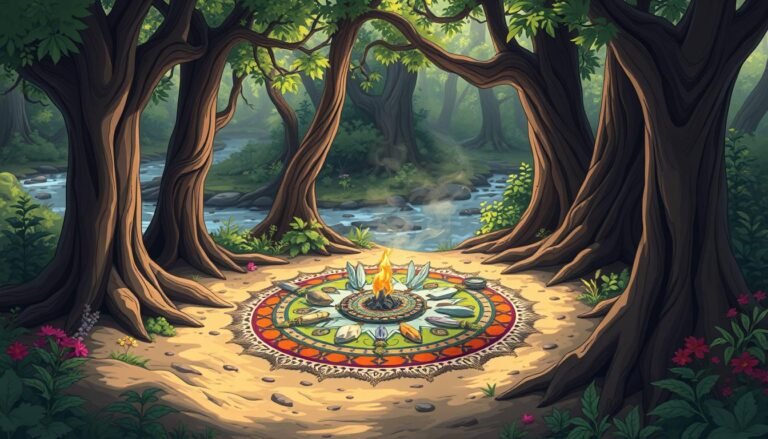Why Are Sacred Spaces So Important in Spiritual Growth?
“The ache for home lives in all of us, the safe place where we can go as we are and not be questioned.” – Maya Angelou’s words capture the essence of sacred spaces in our spiritual journey.
Sacred spaces are key to our spiritual growth. They offer a safe haven from the world’s noise. These places, whether in nature or built by humans, help us find peace and connect with something beyond us.
These spaces can be a cozy corner in your home or a grand cathedral. They act as bridges, linking us to the divine. This connection helps us understand our place in the world.
About 80% of sacred spaces are for religious use, while 20% are natural sites with spiritual value. This mix shows our need for places that connect us spiritually.
Sacred spaces do more than just offer quiet. They are places of healing, inspiration, and finding purpose. By visiting these spaces, we open ourselves to deep spiritual growth and self-discovery.
Understanding the Concept of Sacred Spaces
Sacred spaces are key for spiritual growth. They are places where we can find peace and connect with ourselves. Examples include religious sites, spiritual retreats, and meditation centers.
Defining Sacred Spaces in Modern Context
Today, sacred spaces go beyond just churches. They can be in nature, our homes, or even places like ballparks. What matters is the feeling of calm and connection they offer.
The Role of Sacred Spaces in Various Spiritual Traditions
In many spiritual traditions, sacred spaces connect us to the divine. They are called thin places where heaven and earth meet. These spots help us feel closer to the divine and offer a break from everyday life.
Personal vs. Communal Sacred Spaces
Sacred spaces can be for one person or for many. While places like retreats and meditation centers are shared, we can also have our own at home. Personal spaces might include:
- A quiet corner for meditation
- A garden for connecting with nature
- A special room dedicated to prayer or reflection
Both personal and communal spaces are vital for spiritual growth and peace.
“Sacred spaces are where we can encounter the divine more meaningfully, finding moments of communion between earthly demands and spiritual desires.”
The Psychological Impact of Sacred Spaces
Sacred spaces are key to our mental health. They help us heal spiritually and have deep experiences. Studies show they lower stress and anxiety, making us feel better overall.
The design of these spaces affects how we feel. Symbols, materials, and colors all work together. They create a place for deep thinking and growth.
Here are some key benefits of sacred spaces:
- Enhanced mindfulness and focus
- Improved creativity and innovation
- Stronger social bonds and sense of belonging
- Facilitation of emotional release
- Support for physical and mental recovery
The sacredness of a space also depends on our beliefs and actions. Our personal connection makes these experiences unique and meaningful. It’s a journey tailored to each of us.
“Sacred spaces are vessels for divine energy, catalyzing profound psychological transformations and transcendent experiences.”
Sacred spaces are important, whether for religious or secular reasons. They offer a place for healing, growth, and connecting with something greater. They help us face life’s challenges and find peace within.
Sacred Spaces and Spirituality: A Powerful Connection
Sacred spaces are key for our spiritual growth. They offer a place for divine energy and healing. Places like Hindu temples and Christian churches are designed with special geometry and symbols.
How Sacred Spaces Enhance Spiritual Practices
Sacred spaces help us connect with ourselves and the world. They show our inner world and support our growth. In Islam, prayer spaces are designed to focus on humility, facing Mecca.
The surroundings greatly affect our mood and focus. They can make our prayers better.
The Energy and Atmosphere of Sacred Spaces
The vibe of sacred spaces comes from careful design and meaningful items. Colors like blue or green calm us. Soft textures make a space for prayer and meditation.
Scents from candles or incense can improve our prayer time. Background sounds, like hymns or nature, also help our spiritual practices.
Cultivating Mindfulness in Sacred Environments
Creating a personal sacred space is vital for growth and well-being. Start by decluttering. Then, add personal touches like artwork or scripture.
Practices like gratitude journaling, setting intentions, and meditation boost our connection with the divine. They improve our overall well-being.
“Establishing a sacred space for meditation and prayer was found to be essential in spiritual growth and well-being.”
Creating Your Own Sacred Space at Home

Making a sacred space at home is a rewarding journey. It’s a place to retreat, meditate, and connect with yourself. Unlike meditation centers or spiritual retreats, your home sanctuary grows with you, showing your personal growth and spiritual path.
Start small. Pick a quiet corner in your home with good natural light and few distractions. Clear out this area to bring calm. Add things that touch your soul, like a small altar, a comfy cushion, or a bookshelf for inspiring books.
Consider these items for your sacred space:
- Candles or soft lighting
- Crystals or natural stones
- Personal mementos or photographs
- Incense or essential oils
- Spiritual symbols or artwork
Don’t rush. Build your space slowly, adding pieces that mean something to you over time. This way, your sanctuary grows naturally, just like your spiritual journey.
“Creating a sacred space is one of the most rewarding experiences in life. It fosters a blossoming meditation practice and provides the sanctuary we all long for.”
Make time for your space. Meditate, journal, or just sit quietly. You might also bring in practices from spiritual retreats you’ve been to. As you care for this space, it becomes a powerful tool for self-care and spiritual growth, just like the most serene meditation centers.
The Healing Power of Natural Sacred Spaces
Nature has a special power to heal and inspire us. Natural sacred spaces connect us to the spiritual world, helping us grow and renew. These places, like ancient forests and majestic mountains, open doors to deeper understanding and peace.
Forests, Mountains, and Water Bodies as Sacred Sites
Forests, mountains, and water bodies have always been seen as sacred. They fill us with awe and reverence. A study in Perthshire, Scotland, showed the lasting appeal of these spaces for healing.
Connecting with Nature for Spiritual Growth
Connecting with nature is a deeply spiritual experience. It lets us see beyond our daily lives and connect with something bigger. This connection helps us feel united with the land and find our place in the world.
Eco-spirituality and Sacred Natural Spaces
Eco-spirituality sees nature as sacred and our duty to protect it. It’s about living ethically, being compassionate, and caring for the environment. Natural sacred spaces are key in this approach, reminding us of our bond with Earth and all living beings.
“Spiritual landscapes offer new imaginations of our place in the world and present the unknown.”
By embracing natural sacred spaces, we open up to deep healing and growth. These places are sanctuaries for reducing stress, finding mindfulness, and discovering ourselves. Whether it’s a quiet forest or a serene mountain, nature invites us to reconnect with ourselves and the world.
Historical Sacred Sites and Their Enduring Spiritual Significance
Sacred places have captivated human hearts for centuries. They draw millions to religious sites worldwide. These sites remind us of our spiritual heritage and inspire awe today.
From ancient structures to natural wonders, these locations hold deep meaning. They are important to diverse cultures and faiths.
The appeal of pilgrimage destinations is clear. Millions visit sites like Santuario de Chimayo in New Mexico each year. Places like the Wailing Wall, Ka’aba, and St. Peter’s Basilica have been revered for thousands of years. They cross time and cultural boundaries.
Sacred sites often evoke deep emotions in visitors. This includes both religious and non-religious people. Many feel a divine presence or connection to spiritual values when they visit.
Sacred places are the heart of a culture’s spirituality and history. They offer insights into beliefs, values, and practices of different communities.
Places sanctified by history also hold spiritual significance. The World Trade Center site, Gettysburg battlefield, and former slave trading forts are examples. They acknowledge past tragedies and honor collective memory.
- Indigenous cultures maintain sacred sites crucial to their identity and traditions
- Sacred places often serve ecological functions, preserving biodiversity
- Native American sacred sites embody cultural narratives and spiritual beliefs
Preserving these holy places is key to protecting cultural heritage. It respects diverse traditions. Efforts include legal protection, community involvement, and educational programs.
By safeguarding these treasured locations, we ensure their spiritual significance for future generations.
The Role of Architecture in Sacred Spaces
Sacred architecture is key in creating spiritual experiences. It ranges from ancient temples to modern churches. The design of these spaces helps people connect with the divine.
Sacred geometry is at the heart of many religious buildings. It creates an atmosphere of awe and reverence.
Sacred Geometry and Its Spiritual Implications
Sacred geometry uses specific ratios and patterns believed to hold spiritual significance. These designs are found in religious structures around the world. From Islamic geometric patterns to Hindu temple proportions, they aim to unite the physical and spiritual realms.
How Design Elements Influence Spiritual Experiences
Architectural elements in sacred spaces deeply affect spiritual experiences. In Christian churches, soaring arches and domes symbolize the heavens. Buddhist temples use pagoda roofs and carvings to promote meditation.
Water features in many religions represent purification and life. Colors also hold deep meaning. Gold signifies divinity, while white represents purity.
Famous Examples of Sacred Architecture
Notable examples of sacred architecture show the power of design in spiritual settings. The Kamakhya Temple in India represents feminine energy through its unique structure. Buddhist stupas, like the Chorten near Potala Palace in Tibet, house sacred relics and invite ritualistic practices.
The terraced temple of Borobudur in Java blends Buddhist teachings with stunning architecture. These spaces create transformative environments for spiritual growth and connection.
- Hindu temples with shikhara architecture mimic sacred mountain ranges
- Islamic mosques feature distinctive domes and intricate geometric patterns
- Christian churches often include stained glass windows and cruciform layouts
- Buddhist stupas house relics and encourage practices like circumambulation
“Architecture is the reaching out for the truth.” – Louis Kahn
Rituals and Practices in Sacred Spaces
Sacred spaces are key for spiritual practices and rituals. They connect us deeply with the divine. For centuries, people have used these areas for ceremonies and reflection.
Creating a sacred space can be simple or grand. It might be a small altar at home or ancient temples. Over 90% of those who practice spirituality have a physical space, even if it’s temporary. These spaces help with meditation and rituals, boosting spiritual growth.
Rituals in these spaces use our senses. Incense, chanting, and beautiful altars create a full experience. They help us connect with the divine through actions, sounds, and symbols.
“Sacred rituals are magical moments that enrich life experiences and create lasting memories.”
Only about 10% have a permanent ritual space at home. This shows sacred spaces can be flexible. Many make temporary areas for ceremonies or meditation.
- 70% of individuals use invocation, mantras, or prayer in their sacred spaces
- 80% of practitioners set sacred boundaries in daily life for spiritual growth
- Sincere and dedicated ritual performance often leads to magical experiences
Engaging in rituals in sacred spaces deepens our connection with the divine. These practices offer healing, growth, and transformative experiences. They make our lives richer.
The Transformative Power of Pilgrimage to Sacred Sites
Pilgrimages to sacred sites mix physical travel with deep reflection. These journeys can change lives, offering seekers deep experiences and growth.
Famous Pilgrimage Destinations Around the World
Millions visit sacred sites globally each year. Mount Arunachala in India has been a key site since 1500 BCE. The United States National Park Service also encourages pilgrimages to its 63 national parks, showing the wide range of spiritual journeys today.
The Spiritual Journey of Pilgrimage
Pilgrimage is more than just traveling. It’s a journey with phases of leaving, starting, and returning. Brad and Rita Berglund, leading pilgrimages for over 23 years, say it’s about moving and stepping out of your comfort zone.
Pilgrimage is a practice involving movement through time and space with an open heart.
Modern Interpretations of Pilgrimage
Today, pilgrims seek a deeper connection with themselves. The Global Wellness Trends Report shows a rise in new pilgrimage trails. Also, 88% of people want to visit places that remind them of home, showing a move towards simpler, more meaningful travel.
Despite the costs, many save for years to go on these journeys. Pilgrimage keeps evolving, offering seekers chances for growth and spiritual development in our busy world.
Sacred Spaces in the Digital Age: Virtual and Augmented Reality
The digital era has opened up a new world for spiritual exploration. Virtual sacred spaces and augmented reality are leading the way. With 85% of the world’s population believing in organized religion, these technologies offer fresh ways to practice spirituality.
Digital spirituality is becoming more popular as people look for new ways to connect and grow. A study with 47 Lutheran Christian clergy showed mixed views on using technology in sacred spaces. They found both benefits and drawbacks.
Virtual sacred spaces offer a chance for global spiritual communities to come together. They can do this without being in the same place. These digital spaces let people:
- Experience immersive spiritual practices
- Connect with others from all over the world
- Visit sacred sites from anywhere
Augmented reality in sacred spaces brings both benefits and challenges. It can make experiences better, but it might also change the purpose of these places. The clergy survey showed a mix of opinions on using technology in sacred areas.
“The integration of augmented reality in sacred spaces opens up new possibilities for spiritual engagement, but we must carefully consider its impact on the sanctity of these environments.”
As digital spirituality grows, finding a balance is key. We need to keep the essence of sacred spaces while using new technology. The future of spiritual growth might be in combining old traditions with the new possibilities of virtual and augmented reality.
Maintaining the Sanctity of Sacred Spaces
Sacred spaces face big challenges today. These places, full of history and spiritual meaning, deal with environmental threats, too many visitors, and cultural changes. Saving these sites is a big issue for many groups around the world.
Challenges Facing Sacred Sites Today
Sacred spaces have changed a lot. Once key to medieval life, they now face issues like environmental damage and millions of visitors. This puts a big strain on these important landmarks.
Conservation Efforts for Religious and Spiritual Landmarks
Keeping holy places safe is a careful task. Places like the Balaji Temple in India and the CHIJMES in Singapore show how it can be done. They host events while keeping their spiritual value. Working together between religious leaders and local people is essential.
Balancing Tourism and Sacredness
Spiritual tourism brings both good and bad. It can help local economies but also threaten the sacredness of these places. Good visitor rules and new tech help keep respect and safety. The Al-Ansar Mosque in Singapore is a great example of balancing tradition and modern times. This way, sacred sites stay alive for future generations.
Source Links
- Thinking About Sacred Space
- Sacred Spaces, Sacred Realms: Religious Centers and Pilgrimage Routes
- Creating a Sacred Space – Serenity in Suffering
- Sacred Spaces | John Mackey
- The Psychological Impact of Sacred Spaces on Individuals
- The Power of Human Experience Within Sacred Space
- The Power of Sacred Spaces: How Changing Your Surroundings Can Enrich Your Prayer Life and Energy
- Sacred Spaces | Those Heavenly Days
- How to DIY Your Own Sacred Space
- How to Create a Sacred Space in Your Home
- Sacred Spaces, Healing Places: Therapeutic Landscapes of Spiritual Significance
- Creating a Sacred Space: A Guide to Finding Peace and Harmony
- Why Do Old Places Matter? Sacred | National Trust for Historic Preservation
- Sacred Sites: Indigenous Cultures & Significance
- Architecture and Religion: Sacred Spaces and Spiritual Symbolism
- Sacred Architecture And The Symbolism Of Religious Buildings
- An Introduction to Sacred Space and Ritual Magic
- Creating Ritual: Sacred Space – Natalie Rousseau
- The Transformative Power of Pilgrimage
- The Power of Pilgrimage: Sacred Rite & Paradigm Therapy – Embodied Philosophy
- The Transformative Journey of Pilgrimage with Brad & Rita Berglund – The Allender Center
- Sacred Spaces in the Digital Age: Perceptions of Lutheran Christian Priests on Augmented Reality at Holy Sites
- Perceptions of Lutheran Christian Priests on Augmented Reality at Holy Sites
- Embracing Culture – The Role of Sacred Spaces | Insight
- Sacred spaces – (Intro to Greco-Roman Magic) – Vocab, Definition, Explanations | Fiveable
- Sacred Spaces








